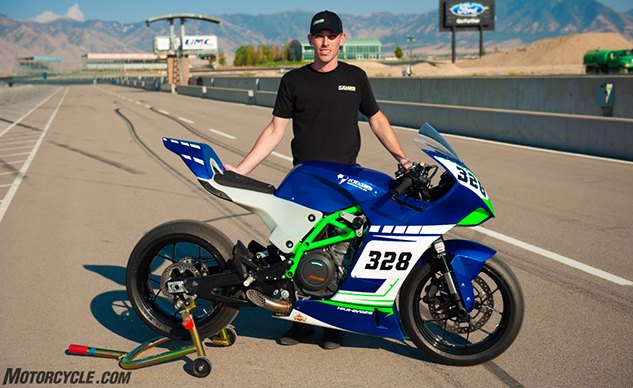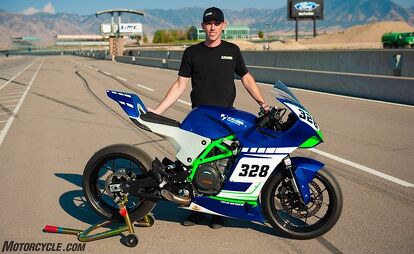Trizzle's Take: You Don't Have To Be In Class To Go To School

A story about how motorcycles brought meaning to someone's life
There’s a motorcycling renaissance happening right now in a location you’d never expect. It’s far from any coast, and temperatures can be downright brutal in the winter. Nevertheless, for three seasons out of the year it’s not unusual to hear the sounds of roaring American V-Twins interspersed with the wail of Japanese Fours, British parallel-Twins, and everything else in between. Motorcycles new and old roam this land, and when the winter months make their presence felt, the locals make lemonade out of lemons – out come the dirtbikes, on go the studded tires, and off to the frozen lakes they go, shredding the ice in the land of never-ending traction.
Where is this mystical locale, you wonder? None other than Fargo, North Dakota. Far from the motorcycling mecca most think of, the scene here has been steadily quiet for a generation, save for the annual trip south to the other Dakota and the Sturgis rally. Today, there’s a growing sense of community in the Fargo motorcycling scene, with more options than people realize, and Joe Karvonen is in the middle of it all.
At just 30 years of age, Karvonen’s path is fascinating – and it’s far from typical. A child from a broken household, he and his brother lived with their mother, moving a lot when he was young. “I went to more elementary schools than I can count,” he says. It’s not hard to imagine, then, that education and academics weren’t high on Karvonen’s priority list. He got his first taste of motorcycling while spending the summers with his dad. As he recalls, “He was a Harley guy, but he had dirtbikes around, too. That’s when I rode my first bike, a Honda Z50.” From there, he progressed to a Honda XR100, then an XR200, which he still owns today. He tried the whole motocross thing, but as any racer will tell you, it was near impossible to afford.
So instead, he went to work. By the age of 14 he was spending his summers packing wheel bearings on hay trailers one day, then prepping brand new Arctic Cats the next. While an Arctic Cat dealership on the surface, Joe remembers the shop he worked at (which is still around today, name withheld to protect the guilty) also sold used cars and offered auto body repair and maintenance work, too. “I’m surprised they didn’t have a hair and nail salon,” he says.
By now Karvonen found himself in middle school. The constant moving had slowed, but the toll it took on him was deep. When you move around as much as he did, writing a book report seems trivial. His grades suffered because he simply didn’t care, dipping so far as to be placed in special needs classes. As he recalls, “I was fully aware they were sticking me in that class. But I didn’t have to try when I was there, so I stayed.”
The academic trend continued into high school, but the turning point came when he discovered shop classes. Welding and Recreational Engines, to be specific. The son of two machinists, it’s only fitting Karvonen found himself gravitating towards those two subjects. He took a deep interest in the engines class, which gave him the motivation to continue in school. Eventually, he took the lead in a hypermile competition his school entered, modifying a five horsepower Briggs & Stratton engine to accept a Honda Z50 piston and cylinder head. Ultimately, his school’s entry was able to get a whopping 442 miles per gallon from the engine, at an average speed of 35 mph, for six miles.
It was through the Recreational Engines class that Joe discovered SkillsUSA, and its national competitions in a variety of subjects, from cosmetology to motorcycle repair. Taking part in his junior year, he placed second in the national competition. Looking to do one better in his senior year, he entered again – and won. From there a move to Arizona followed, where a full scholarship to the Motorcycle Mechanics Institute awaited. The victim of bad timing, he graduated in the middle of the economic recession, forcing him to move back home to Fargo.
A series of jobs at Fargo dealerships followed, but he eventually quit and looked for jobs outside the motorcycle industry. In the meantime, he built a shop to work on bikes as a hobby instead of a profession. But there’s a funny thing about being a national-champion-caliber technician in a small town like Fargo: Word gets around quickly. Soon, Fargoans were bringing their motorcycles to Karvonen – partly because of his skill, but also because options are slim in this town. Soon, he was making more money than he ever did at the dealerships, and Sisufab was born. After a year he was so busy he hired his first employee.
Putting the community’s motorcycles back on the road delivered a sense of gratification Karvonen didn’t expect. In his own little way, he was giving back to his community. Two years ago, he decided to go all-in. With flat track being all the rage these days, he had heard about the local indoor flat-track races Fargo was locally famous for several decades ago. With nothing more than curiosity and the internet, he decided to investigate the logistics of reviving the indoor flat track scene in Fargo. Soon he discovered the fairgrounds and the building that used to house the races; it was still standing, and was surprisingly cheap to rent. The catch was insurance – as a surprise to nobody, insuring a flat track race was astronomically expensive.
Hope was not lost, however. Adjacent to the original building was a ⅜-mile oval already hosting karting events – a perfect venue for flat track. After talking with the owner, he liked the idea of running flat track races on his track, and the insurance was much more affordable. A deal was struck! There was only one catch: All motorcycle activity had to be run at night, so karting could take place during the day.
With that, Joe and his wife, Brittany (an architect by day), went to work promoting their new series Flat Out Fargo. “All we did was go on social media and promoted like hell,” says Karvonen. “Next thing you know, 1100 people showed up and we had 55 race entries!” He adds, “Remember, the stadium was built to house 1,700 people who are 18 inches wide. We had 1,100 people who definitely were not 18 inches wide!” Needless to say, the event was a hit and it’s grown ever since, attracting even more people in 2018 (its second year), including participants from several states away. All because of a local curiosity he wanted to explore.
On a personal level, I met Joe through his other business, being the sole distributor of Kramer Motorcycles in America (which is another story entirely, but that’s a Kramer in the lead image). A cold call via social media put us in touch, and I’ve since gone on to meet him (and Brittany) in person and race Kramers with varying levels of success (those stories to come soon). As I called Karvonen to chat and get more information, he tells me he had just gotten off the phone, not ten seconds prior me to calling, with someone looking for obscure parts for his pre-Polaris Indian. Oddly enough, he had them. He usually does. This is the kind of thing that makes Karvonen a go-to motorcycling resource in a small town like Fargo. Locals are now encouraged to dust off their bikes and ride, because they know Joe is there if they need him. As a result, Joe and Brittany have now found themselves in the middle of a rebirth in the local motorcycling scene. It’s hectic and crazy most of the time – and there are some weekends they wish they could be as far away from a motorcycle as possible – but deep down inside they can’t help but feel proud of what they’ve accomplished. And the work isn’t done.
Not everyone can be a straight-A student and be voted most likely to succeed – Joe Karvonen is proof positive the trades are a fine alternative to traditional schooling. In the process, he’s revitalized a whole town.

Troy's been riding motorcycles and writing about them since 2006, getting his start at Rider Magazine. From there, he moved to Sport Rider Magazine before finally landing at Motorcycle.com in 2011. A lifelong gearhead who didn't fully immerse himself in motorcycles until his teenage years, Troy's interests have always been in technology, performance, and going fast. Naturally, racing was the perfect avenue to combine all three. Troy has been racing nearly as long as he's been riding and has competed at the AMA national level. He's also won multiple club races throughout the country, culminating in a Utah Sport Bike Association championship in 2011. He has been invited as a guest instructor for the Yamaha Champions Riding School, and when he's not out riding, he's either wrenching on bikes or watching MotoGP.
More by Troy Siahaan











































Comments
Join the conversation
Very proud of my brother-in-law, Joe. One thing the article doesn't mention is how awesome he has been with motors even before he went to UTI. This guy put a new head gasket in my car when he was like 15!
Great story and nice shout out to Mike Rowe. That guy is tireless in his promotion of the trades.